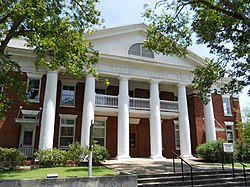Harris County, Georgia | |
|---|---|
 County courthouse in Hamilton | |
 Location within the U.S. state of Georgia | |
| Coordinates: 32°44′N84°55′W / 32.74°N 84.91°W | |
| Country | |
| State | |
| Founded | December 14, 1827 |
| Named after | Charles Harris |
| Seat | Hamilton |
| Largest city | Pine Mountain |
| Area | |
• Total | 473 sq mi (1,230 km2) |
| • Land | 464 sq mi (1,200 km2) |
| • Water | 9.1 sq mi (24 km2) 1.9% |
| Population (2020) | |
• Total | 34,668 |
• Estimate (2024) | 36,929 |
| • Density | 74.7/sq mi (28.8/km2) |
| Time zone | UTC−5 (Eastern) |
| • Summer (DST) | UTC−4 (EDT) |
| Congressional district | 3rd |
| Website | www |
Harris County is a county located in the west-central portion of the U.S. state of Georgia; its western border with the state of Alabama is formed by the Chattahoochee River. As of the 2020 census, the population was 34,668. [1] The county seat is Hamilton. [2] The largest city in the county is Pine Mountain, a resort town that is home to the Franklin D. Roosevelt State Park (the largest state park in Georgia). Harris County was created on December 14, 1827, and named for Charles Harris, a Georgia judge and attorney. [3] Harris County is part of the Columbus, GA-AL metropolitan area and has become a popular suburban and exurban destination of residence for families relocating from Columbus. Because of this, Harris has become the sixth-wealthiest county in Georgia in terms of per capita income and the third-wealthiest in the state outside of Metro Atlanta.


